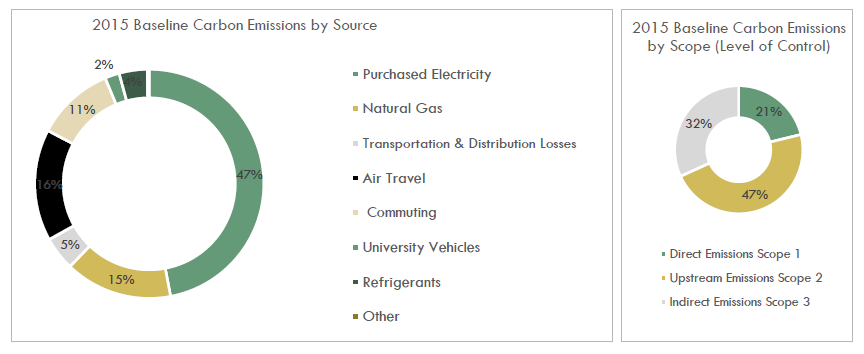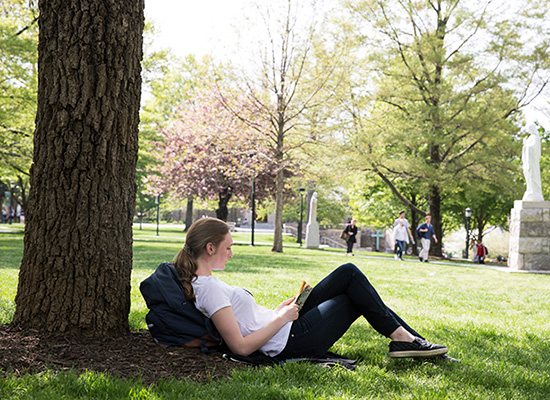Climate Action
Loyola recognizes the important role of higher education institutions to shape a sustainable future for all. As a justice driven Jesuit institution Loyola University Maryland is committed to acting on climate change.
The Rev. Brian F. Linnane, S.J., now president emeritus, demonstrated this commitment by signing the Catholic Climate Covenant's St. Francis Pledge to Care for Creation and the Poor and the President’s Carbon Commitment in 2015. As a signatory, Loyola committed to developing institutional structures and long term strategies to reduce our carbon footprint to achieve carbon neutrality and engage our community in action on climate change.
Climate Action Updates

Strategy 1A: The Energy Committee successfully conducted an AHREA Level II Energy Audit to determine high impact energy conservation projects across campus and an RFP is being developed to implement identified energy conservation measures (2021).
Strategy 1A: The Sustainability Committee is drafting a Green Building Policy to ensure all campus construction follows the USGBC LEED framework for sustainable buildings (2021).

Strategy 3C: Loyola Sustainability secured grant funds to implement a zero waste events program and the Sustainability Committee is developing a Zero Waste Plan to guide a comprehensive and justice driven waste reduction and recycling strategy (2020).

Strategy 4A: Energy Revolving Fund established by Business and Finance Division to divert funds generated by energy savings projects into additional sustainable infrastructure (2020).
Loyola's Carbon Footprint
Baseline 2015 Green House Gas Inventory

Climate Action Plan
The Loyola University Maryland Climate Action Plan is our roadmap to reduce our carbon footprint and act on climate change. The plan was developed over two years by the Sustainability Committee, various subcommittees and stakeholders from across campus. The plan outlines strategies and goals which will guide the university on an actionable path to reduce our carbon footprint and achieve carbon neutrality by 2050. The Climate Action Plan is intended to evolve with ever-changing opportunities to act on climate change at Loyola, locally and globally.
Carbon Neutrality
Achieve carbon neutrality by 2050
Reduce energy consumption 20% by 2030
Invest in 50% renewable energy by 2030
Goal 1: Save Energy
Strategy A: Improve Our Buildings
Audit and track high energy consuming buildings to implement impactful energy savings projects, purchase Energy Star equipment, and strive for LEED Gold for new construction.
Strategy B: Invest in Renewable Energy
Integrate renewable or renewable ready infrastructure into new construction and invest in both on campus and off campus renewables.
Strategy C: Energy Engagement
Host climate action awareness week annually and publicize utilities data to campus community.


Goal 2: Travel Lighter
Strategy A: Green Our Commutes
Better understand commuting patterns, support alternative commuters, enhance pedestrian experience and support the availability of public transit in Baltimore.
Strategy B: Offset Flights
Encourage local professional development opportunities and video conferencing and develop a local carbon offset program to offset emissions generated by campus flights.
Strategy C: Purchase Alternative Vehicles
Centralize vehicle purchasing and develop standardized vehicle purchasing guidelines which prioritizes fuel efficient, electric and hybrid vehicles.
Climate Change Education
Goal 3: Engage All Levels of the University
Strategy A: Teach Sustainability Across the Curriculum
Create resource bank for sustainability and climate change modules, establish a sustainability
course requirement, introduce academic programs which support environmental learning
and expand the environmental studies minor into a major.
Strategy B: Reimagine the Campus Landscape
Expand the role of the campus landscape to support native biodiversity, protect the local ecosystem and inspire environmental stewardship by investigating advanced storm water management techniques and enhancing the visibility and academic use of the Loyola Arboretum and community garden.
Strategy C: Reduce Waste
Develop a Zero Waste Plan to standardize recycling and waste operations across campus and engage the Loyola community in waste reduction and proper sorting at campus events and orientations.
Strategy D: Sustainable Purchasing
Develop sustainable procurement language to ensure purchased goods and services align the university's commitment to sustainability.
Implementation



Goal 4: Sustain Climate Action
Strategy A: Finance Climate Action
Establish a Revolving Energy Fund, incorporate energy reduction goals into capital requests, investigate giving opportunities for scholarships and projects and develop funding source for Scope 3 emissions.
Strategy B: Communicate Climate Action
Host the Climate Action Plan as a living and evolving document on the Sustainability website with clear action items for stakeholders and communications for the campus community.
Strategy C: Track and Update Progress
Track and report carbon footprint to Second Nature annually and update the Climate Action Plan at least every three years.
View the full Climate Action Plan
Climate Action Plan Download (PDF)



